Fabric Tests for Concrete Draping
Halloween brings out all the spooks, ghouls and witches! So you need to know how to work with concrete fabric draping; it’s an essential concrete skill. So many choices… so many results. I’ve done a few Fabric Tests for Concrete Draping so you can get to making in time for Halloween!
The Magic in the Mix:
Portland cement is my ingredient of choice. I know many do add other things like sand but I like the way this simple mix behaves. I tend to learn from doing and testing. My ghoul/spook has sat out on a stump through much weather here in Canada, super cold, wind and even crazy heat. He’s been quite smothered in snow and has lasted without any deterioration for over 2 years, so this year there is a surprise addition to his family!
When mixing up the slurry to dip your fabric/fibre in it needs to be thin enough to get into the fibres. That is why I do not use a sand mix as I would find the sand would just end up accumulating in the bottom of the bucket since it had a hard time getting into the fabric.
I will however add some additive many times; just a small ‘squirt’ of acrylic paint. It doesn’t really add much if any colour but does change the consistency slightly and is believed to add strength. It seems to immediately add some thickening to the slurry.
The Fabric Tested:
Since I do a lot of sewing I have a variety of fabrics. Here I have tested typical readily available ones; (upper left to right) Wool Blanket, Fuzzy polyester polar fleece, poly-cotton sweatshirt, cotton flannel, Denim, Cotton T-shirting, Cotton Towel and thin Polyester Quilt Batting.
Make sure to dampen your fabric before dipping as then it will not ‘steal’ the moisture from the cement mix.
Muck Time:
Make sure to fully incorporate the ‘slurry’ into the fabric. Knead and turn and squeeze until you can see it ooze in/out of the fabric; that is very important. Yes, it gets a bit messy so cover the work area, but then again so is making a pie… Be aware that once the fabric is dipped it will gain a lot of weight so be prepared with your vessel or armature so that it will support the weight.
(Tip: Since I did this indoors I had a bucket of water to dip my hands into to avoid any concrete into the sink.)
All dipped and ready to cure. If it is very hot or dry mist with water to slow the drying and make the concrete stronger.
As it cures the thicker mixes are taking more time and thus look darker.
The Results:
Since some of the fabrics have a tighter weave they will have less ability to absorb the portland cement and thus end up quite thin. They have set nicely but feel fragile and easily broken or squished.
To remedy that you can add more layers of the Portland cement slurry to reinforce and add thickness. You can also do this to smooth any unwanted texture.
I decided to add a layer to all the tests except the towel and the polar fleece. They were quite strong all by themselves!
The Final Observations:
The Wool Blanket:
I was somewhat surprised at how the blanket did absorb the cement. It was a vintage blanket so it was quite thick and thus less able to get into folds and drape nicely. It will hold up quite well though and be fairly smooth. I do wonder though if the since it is a natural fibre it would eventually breakdown inside the cement thus losing some of it’s reinforcing properties.
The Polar Fleece:
This looks quite lumpy and thick since it does get a lot of mix into the fibres. It is great to look like a fur or you can smooth it with a brush just after dipping. (as I did with the spook) It was the strongest of all the tests though due to sheer amount of cement. Since it is polar fleece it is 100% polyester meaning it will take a long long time to breakdown so it will lend it’s reinforcing properties for a long time!
The Sweatshirt Fabric:
This fabric absorbed a medium amount of cement, and could be textured depending on which side of the fabric outward. I did feel it needed extra reinforcement though just as a precaution. It does allow smaller details and folding than the thicker fabrics.
The Flannel:
Flannel has some fuzziness that will hold the mix but really not enough to leave as is. It could however work nicely if you have many folds and layers as that would give it strength. It was one thickness so it definitely needed extra coatings. The lumps were from some of the bits that were in the portland cement. I later put it through a sieve to get rid of them (like flour sifting). The witch was made with a velour fabric which is fuzzier than flannel and it worked quite well.
The Denim:
This denim was one of the thinner types of this day and probably had some slight polyester content in it. Being a tight weave it was very thin and fragile. Since it is a weave and does not stretch it will not drape as well as a knit which gives it limitations. Being quite smooth it shows the brush marks thus making it not one of my first choices.
The T-Shirting:
Cotton tends to absorb a lot so this did as well however it is still limited to it’s thin thickness. It does drape quite well and could benefit from much layering and folds but at a single thickness would need many extra coatings.
The Cotton Towel:
As you see this is really nubbly from the towel textures. Obviously a towel is made to absorb so it does quite well and has good strength. Like the fleece it will however have texture unless it is filled/brushed with more mix. It can drape quite well since it was an old well worn towel.
The Quilt Batting:
I had just come across this and thought it may surprise me. Since it has a fairly large open fibre it does grab a lot of mix but the excess texture does not show that well. It also tends to look ‘hairy’ from the fibres. It was fairly strong but did not give a good edge so it would have limited applications.
Go Make Some:
Now that you have an understanding of how easy it is who knows what you can make?!
I will be having a new addition to my family; to my concrete family that is! I have a new ebook for download to make this sweet Cat… Just in time for Halloween.
Happy Concreting!
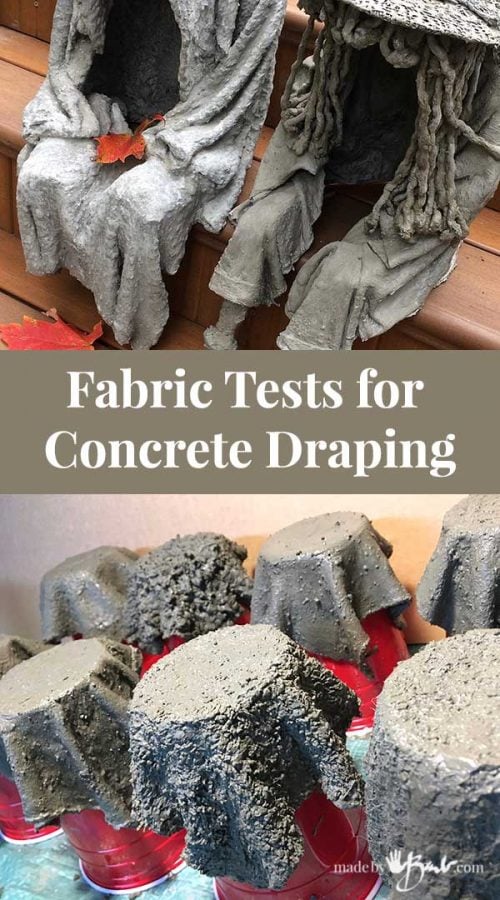
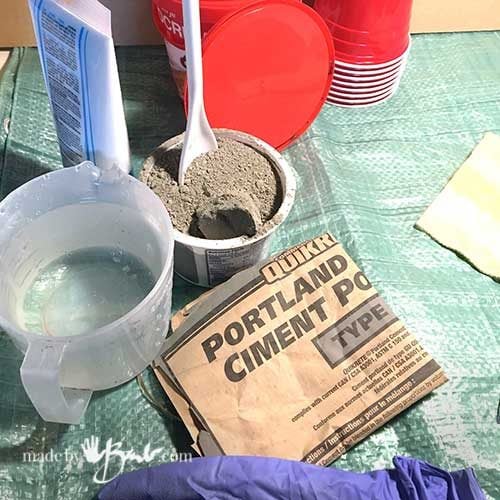
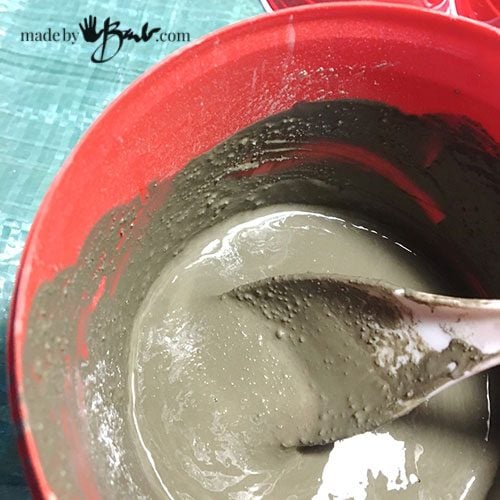

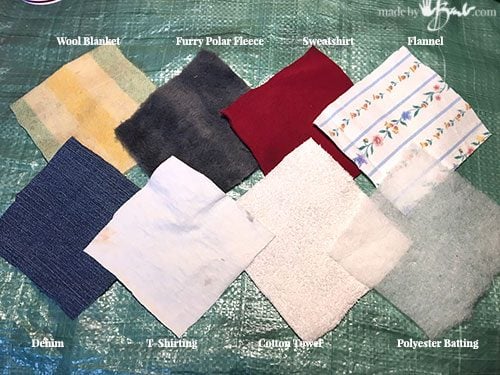
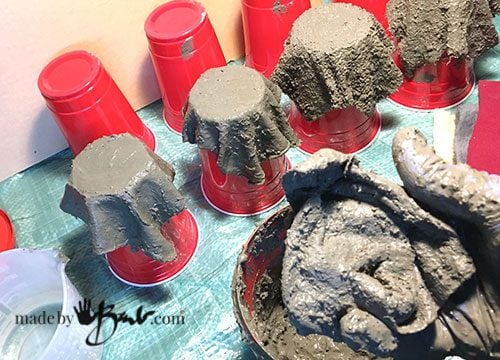
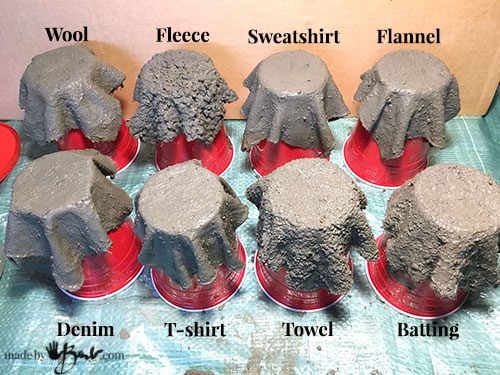

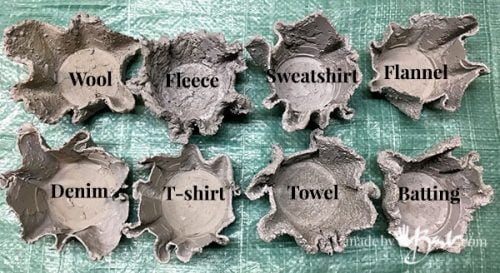
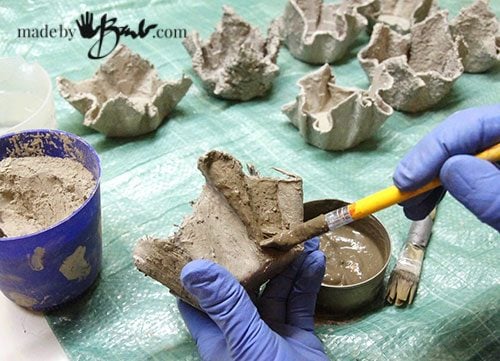
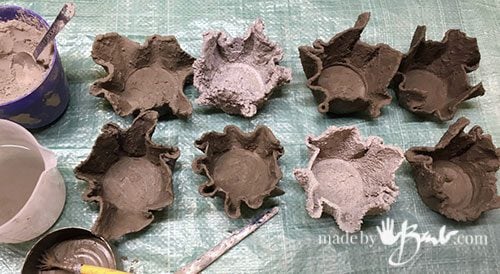
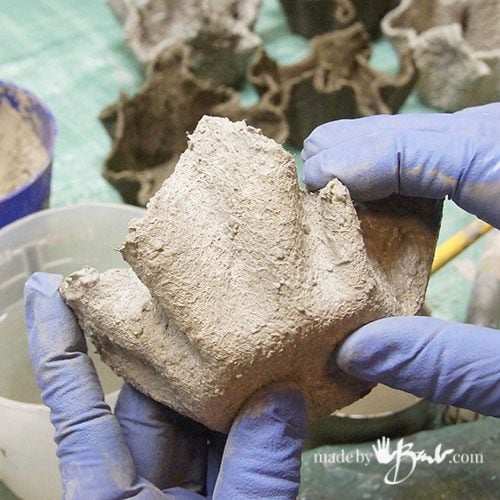
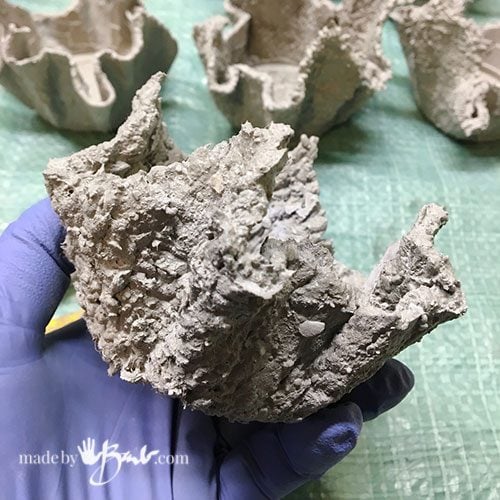
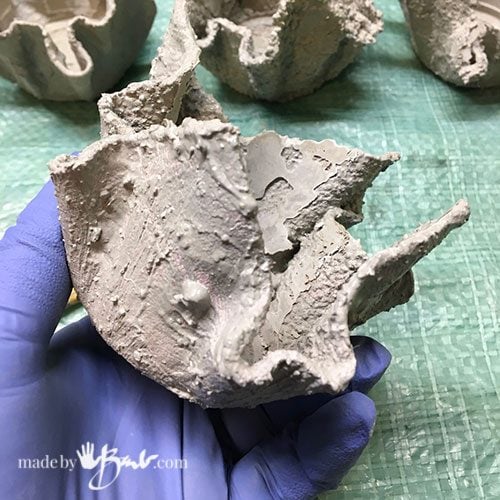
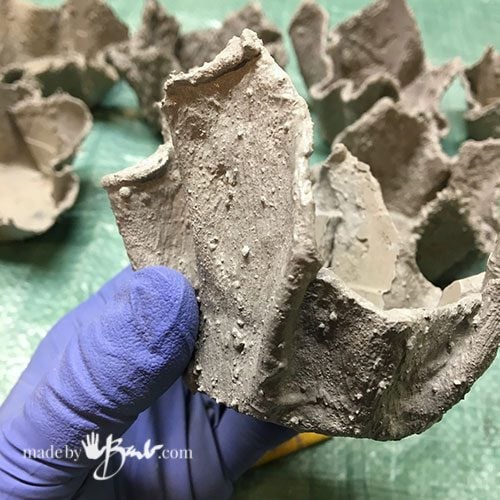

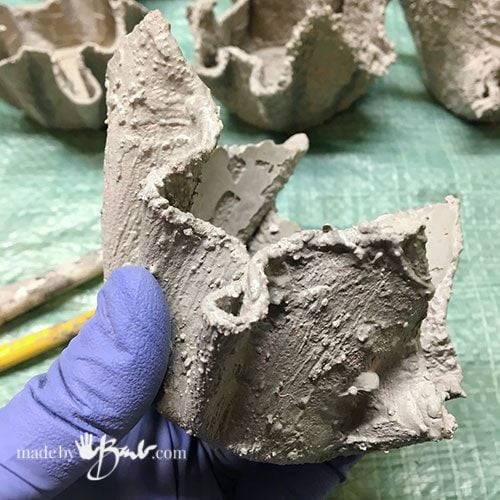
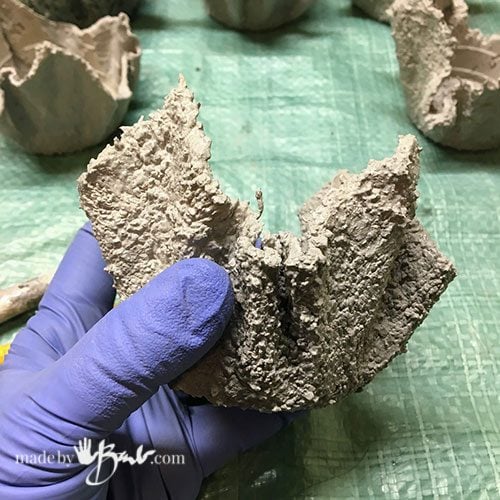
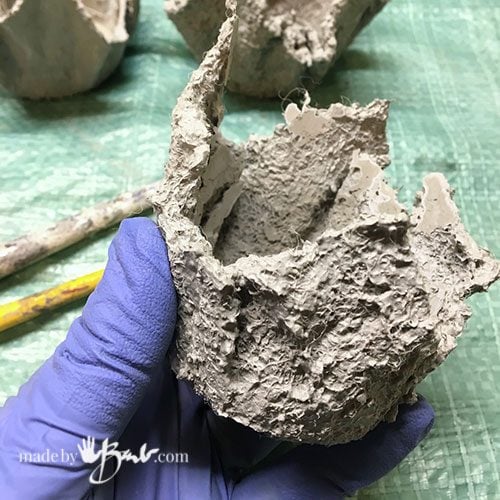
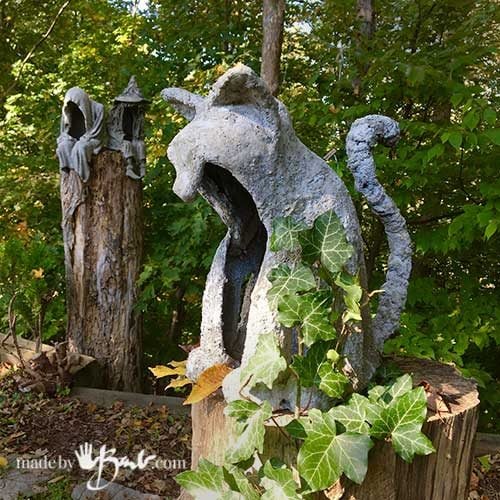
Love your work!!
I have a question for you. I am wanting to create a fountain. More specifically, a piano fountain
My thought is to use your method with t shirt fabric and drape it on an old piano. Creating the shape. Do you ever do large projects like that and do you ever use wood as a base?
Thanks for your time.
Kathie.
I have made waterfall but it’s not as big as a piano. It has been through a canadian winter already once! Wood is not a good thing to use as it will expand and absorbs water so the outer concrete would crack. You could remake a piano out of styrofoam shapes/sheets and then coat those as I did with the waterfall. T-shirt fabric does not hold much of the cement so I’d suggest something that can absorb more, or do a couple layers. Why not do a test piece with some found styrofoam to see how you like it… It would be lighter too! It also give you the option to scale it smaller.
Do these fibers deteriorate in concrete over time? Thanks in advance.
Well, my step spook has been sitting on the stump for almost 7 years, and I’m in canada. He’s out in all seasons, but he does not get immersed in water, but wet and frozen!
Thank you for testing these. I have some 6 mil felted plastic fabric that I am thinking about using. This really helps me with my decision. I plan on trying something I have never seen tried before. I want to sandwich wire between concrete cloth and construct a wall in our backyard. Which sounds ugly I know. However, on this wall I want to plant creeping figs. Which are evergreens, so there won’t be any wall reveals in the Winter. They should completely cover the wall.
That sounds interesting… I like to push the boundaries of concrete as well! Best of luck. I’d love to hear how it goes!
What type of fabric did you use for the figures in the background on the stump?
That would be the ghoul/spook . I used a polyester fleece. You can see the process there. It has lasyed really really well!
Is it possible to paint concrete on an object versus emerse in liquid concrete . Will it stick to plastic, leather, if painting on an object that you want to concrete the entire object? example an old handbag or workboots to preserve and make interesting garden decor.
It will not stick to plastic or shiny things coated with some acrylic finish. Maybe old leather could be roughed up to adhere sheets of the dipped fabric (like paper mache) The leather would rot eventually though in side. If it’s garbage anyways… give it a try.
Love your work!
Thanks! Look around, happy to have you join me!!
Hi , thank you for testing various fabric , have you tried hessian? Cheers Sye
I have used some burlap (similar to hessian?) quite well for these bowls and these bags . If it does not absorb enough, an extra layer be painted on. Best of luck!
Hello Barb!
I already know that you are amazing, but to learn today that you’re also in Canada takes the cake! 🙂 You have given me an itch to try this craft now and the fabric testing really helps!
Thanks SO much!!
Glad to inpsire… it’s getting cold; time to get the concrete stuff done.
I love your creativity. I will try and make some that look like plant pots. I just have to wait for the nicer weather!! You are VERY talented and CREATIVE!!!
Oh yes, I know… Canada doesn’t have that many great concreting months! Enjoy!
Hi Barb. Another award-winning post. On the stool, what fiber did you use? Did you sand it to get such a uniformly smooth texture?
I have not made the stool yet, but the key to getting a smooth finish is making sure the slurry has no lumps. I liken it to working with flour, perhaps sift the Portland cement first. I can also add a layer to smooth by wet brushing. Stay tuned… ‘hoping to put designs into action soon!